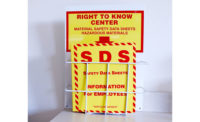Improving workplace safety and sustainability requires the ability to visualize trends in performance, anticipate and manage risks, and identify areas of concern — so they can be quickly and accurately addressed. We should be simultaneously looking for ways to optimize our EHS metrics programs if we want to better safeguard our employees and the environment.
These days, when we talk about EHS metrics, the discussion should include the systems and technologies we use to manage them. It’s impractical to expect EHS professionals to try and manage the high volumes of data, analysis and reporting that’s needed to assess EHS performance without the help of software.
The following are five strategies you can implement to help strengthen your EHS metrics program.
1) Maximize the quality of your data
When it comes to workplace safety and sustainability, the lives of your workers and the fate of your business can literally depend on the quality and accuracy of the EHS data you collect. To help maximize the quality of your data, consider implementing the following measures:
Plausibility Review: This feature of EHS software programs allow users to define an acceptable standard deviation or percentage variance for individual metrics, and automatically flag data outside of acceptable ranges. By helping to eliminate data entry errors, the feature simplifies data QA/QC processes.
Automated Unit Conversions: Data is frequently recorded in different units depending on location or reporting requirements. This feature automatically converts metric units according to user preferences to help eliminate calculation errors, and allow for faster analysis and reporting.
Mobile Access: Mobile apps and other software tools allow users to enter data directly on-site in real-time using their tablet or smartphone. This not only helps to reduce errors and improve quality by making it faster and easier for users to collect and record data, but also eliminates the need for paper forms and manual data transcription.
2) Coordinate your data collection workflows
An effective EHS metrics program relies on more than just good data. You must also coordinate and manage the various tasks and other information that supports your data collection activities. Start by determining the following:
- Data sources (i.e. what will be measured and where?)
- Frequency of data collection
- Personnel responsible for data collection and entry
- Data collection methods and procedures
- Data collection equipment requirements (monitoring devices, PPE, sampling materials, etc.)
3) Establish and closely monitor performance targets
Managing and improving EHS performance requires setting targets, and having the ability to track progress against those targets. Most businesses benchmark their performance against existing historical data, or against external sources such as competitor performance or industry averages for common key performance indicators (KPIs). Whatever benchmark data you select, make sure that it is:
- Objective: Data should be quantitative to help eliminate potential bias from qualitative factors
- Statistically valid: Data should be representative of a sufficiently large sample size to draw meaningful conclusions
- Comparable: Data is representative of your industry, risk level, company size, location, time period, etc.
4) Simplify data visualization
Having the ability to more quickly and clearly evaluate relevant KPIs is essential to making smarter, more responsive EHS management decisions. Some helpful data visualization tools include:
- Dashboards: Dashboards are a centralized interface for users to view and evaluate metric data. Customizable dashboards allow users to specify which metrics they want to display, and can even provide the ability to drill into individual metrics to view details about underlying data.
- Metric Tagging: Metric tagging is a feature included with some EHS metrics software systems that lets users assign keyword “tags” to individual metrics, allowing them to be easily searched, filtered and populated in reports.
- Report Scheduling: Another feature of some EHS metrics software systems is the ability to automate recurring delivery of specified metrics reports to designated individuals. This helps you to meet the data and reporting needs of a wider range of stakeholders’ with minimal time and effort.
5) Apply continuous improvement principles to your EHS metrics program
Like any other EHS management system, your EHS metrics program should undergo periodic review to evaluate and refine your metrics and KPIs, data collection workflows, analysis and reporting practices, data management systems, and all other aspects of your program. This helps identify what metrics provide value to the business, eliminate ones that don’t, and continuously improve the overall accuracy and efficiency of your EHS metrics program.
The Plan-Do-Check-Act (PDCA) cycle provides an excellent model for this review process using the following steps:
- Plan: Identify opportunities for improvement and make recommendations for proposed program changes
- Do: Implement proposed changes through formal change management (MOC) processes
- Check: Gather data, analyze, and validate new or modified metrics
- Act: Determine whether or not EHS metrics program changes have achieved the desired outcomes
It’s important to remember that changes to your EHS metrics program should always follow a formal management of change (MOC) process. This ensures that any proposed changes are sufficiently planned, all potential risks and impacts have been considered, all relevant stakeholders are consulted, and any changes are introduced systematically.
Final thoughts
While we’ve identified five areas that you can focus on to help refine your EHS metrics program, there are many other potential areas for improvement and tools you can add to your program to gain even greater visibility and control of EHS performance. As you explore the solutions available to you, remember that EHS metrics program improvements are one of the best investments you can make toward building a safer and more sustainable workplace.







